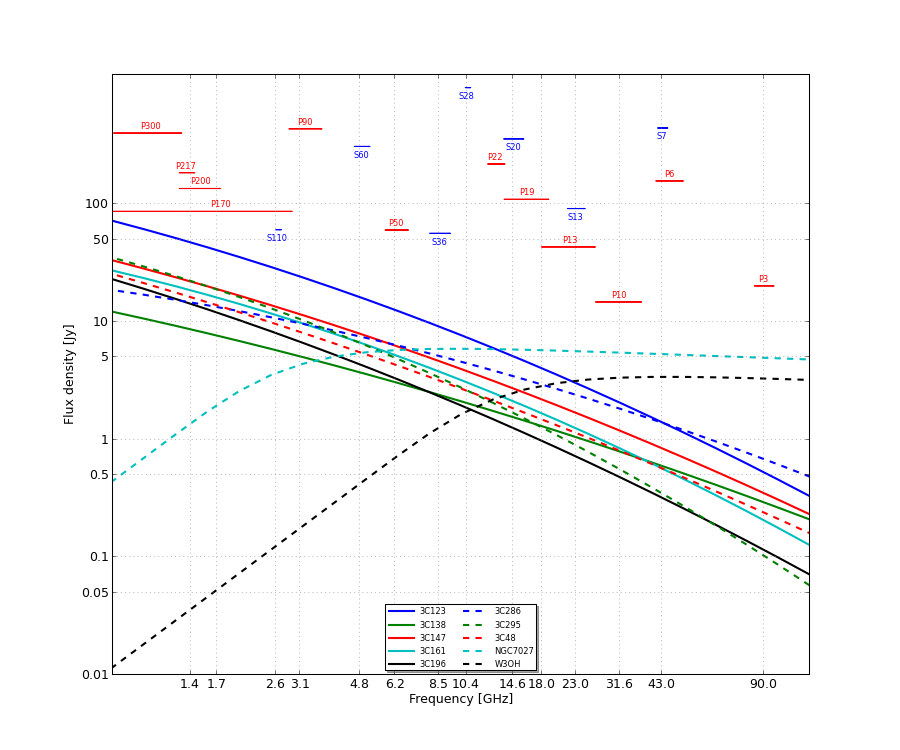Information for Astronomers
User Tools
Sidebar
Table of Contents
Calibrators and their Polarization
The table/figure was created from test-, pointing, and VLBI calibration measurements taken between 1990-2010. By courtesy of Alex Kraus and Uwe Bach.
Polarization properties
Table 1 Shows a summary of percentage polarization and PA. PA determination is more uncertain if the source is less polarized. Another good calibrator is NGC7027 that should have no linear polarization at any frequency.
| Source | 21cm | 18cm | 11cm | 6cm | 3.6cm | 2.8cm | 2cm | |||||||
|---|---|---|---|---|---|---|---|---|---|---|---|---|---|---|
| <m> [%] | <PA> [deg] | <m> [%] | <PA> [deg] | <m> [%] | <PA> [deg] | <m> [%] | <PA> [deg] | <m> [%] | <PA> [deg] | <m> [%] | <PA> [deg] | <m> [%] | <PA> [deg] | |
| 3C286 | 9.02 | 32.8 | 9.88 | 33.0 | 10.06 | 33.0 | 11.01 | 33.0 | 11.19 | 33.0 | 11.71 | 33.0 | 11.93 | 33.1 |
| 3C48 | <0.3 | – | <0.3 | – | 1.61 | 70.1 | 4.19 | 106.6 | 5.39 | 114.5 | 5.90 | 116.1 | 5.89 | 114.0 |
| 3C138 | 7.64 | -10.0 | 8.29 | -11.3 | 9.76 | -10.4 | 11.17 | -11.1 | 10.68 | -10.2 | 10.59 | -9.9 | 5.48 | -15.2 |
| 3C147 | <0.3 | – | <0.3 | – | <0.3 | – | <0.3 | – | 0.93 | -28.7 | 1.15 | 17.6 | ||
| 3C161 | 5.78 | 30.3 | 9.75 | 125.9 | 10.18 | -4.4 | 4.87 | 122.5 | 2.59 | 99.9 | 2.46 | 93.5 | ||
| 3C196 | 1.12 | 23.9 | 0.31 | 28.9 | 1.19 | 54.2 | 2.46 | 122.4 | 1.51 | -11.9 | 1.43 | -33.9 | 0.88 | -27.4 |
| 3C295 | <0.3 | – | <0.3 | – | <0.3 | – | <0.3 | – | 0.93 | 28.9 | 1.73 | -24.5 | 1.99 | 95.4 |
| 0836+71 | 6.77 | 80.0 | 7.50 | 88.2 | 8.00 | 99.3 | 7.77 | 104.6 | 4.87 | 109.4 | 5.24 | 107.0 | 4.25 | 108.3 |
Flux density values
Figure 1 The plot shows measured flux densities of calibration sources as a function of frequency. It also visualizes the parts of the spectrum covered by Effelsberg receivers (red: primary focus, blue: secondary focus). Note that 3C123 is not point-like, so be careful at higher frequencies, 3C138 is somewhat variable, and below 10 GHz W3OH suffers from confusion.

Download PDF version

